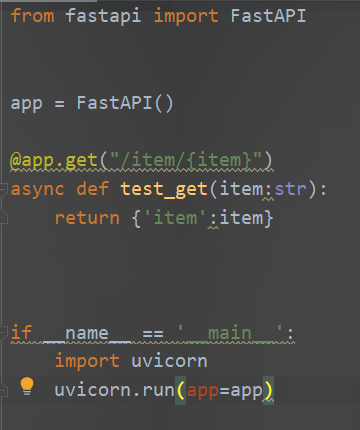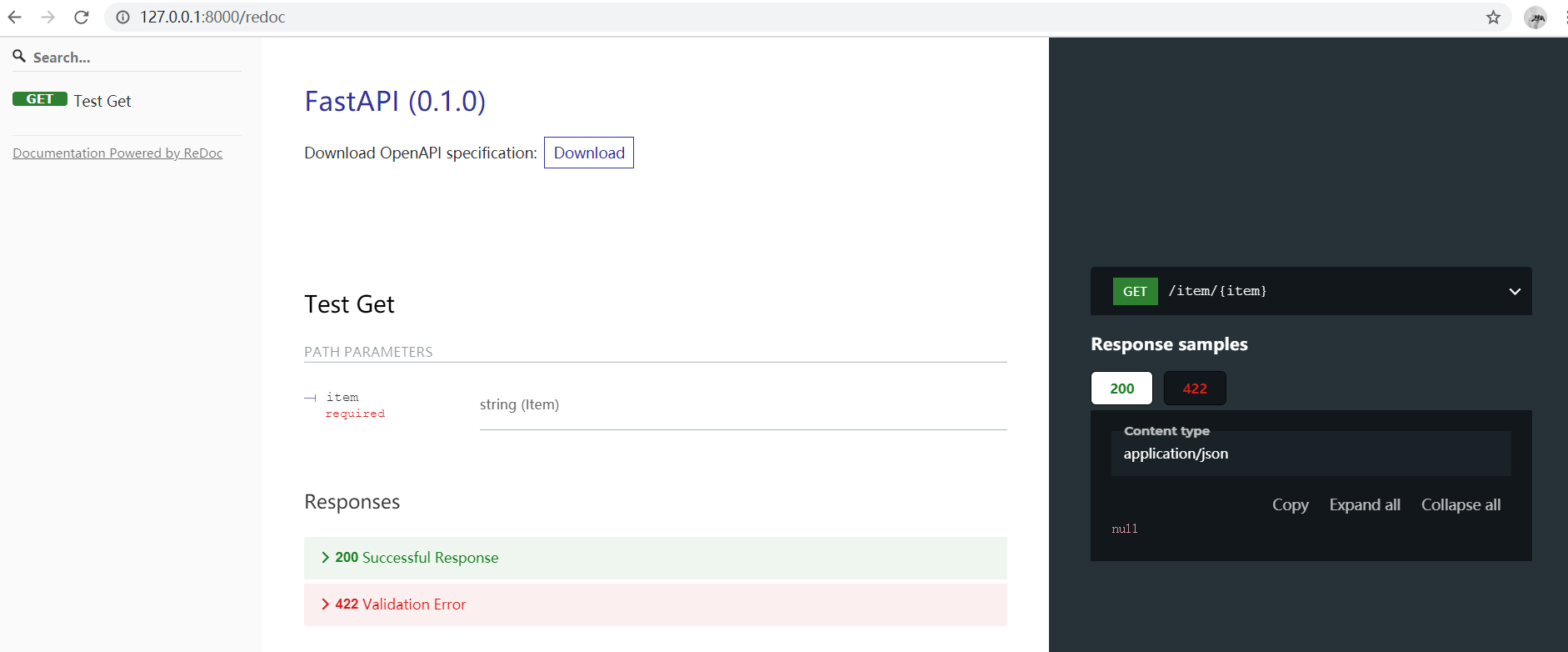FastAPI框架
FastAPI 是一个用于构建 API 的现代、快速(高性能)的 web 框架,天生的支持异步(async)
它的主要优势在于,高效,几乎可与NodeJS和Go比肩的极高性能,自动生成交互式的文档,省去了开发之后写文档的步骤
安装
好了话不多说,我们从头开始,边学边补充吧,争取细到不能再细
首先是安装,安装非常的简单
pip install fastapi
pip install uvicorn好啦,完成之后,做一个基础的API吧
创建py文件
from fastapi import FastAPI
app = FastAPI()
@app.get("/")
async def root():
return {"message": "Hello World"}from fastapi import FastAPI这是一个python类,提供了API的所有功能app=FastAPI()将该类实例化@app.get('/')定义路径操作装饰器,告诉FastAPI是正下方的功能负责处理该请求,可用的其他方式:@app:get() @app.post() @app:put() @app:delete() @app.options() @app:head() @app:patch() @app:trace()async def root():定义路径操作功能,带有async功能的函数return {"message": "Hello World"{返回内容,默认是一个json格式,还可以返回dict、list、str、int等类型,还可以返回Pydantic模型
运行项目
在终端中输入
uvicorn main:app --reload``main:main.py
文件app:app = FastAPI()实例化的FastAPI对象–reload`:在代码更改后重新启动服务器
第二种方法:
程序入口直接运行:
import uvicorn
if __name__ == '__main__':
uvicorn.run(app=app)
#还可以指定host,port等声明类型
FastAPI的类型声明使用的是 :
做个例子:
from typing import str
def get_full_name(first_name,last_name):
full_name = first_name.title() + " " + last_name.title()
return full_name
# 上面这是没加类型提示的
def get_full_name(first_name: str, last_name: str):
# 这事加了类型提示的,添加了这个类型提示不会改变原来的运行结果这个呢,大家把它当做习惯就好了,无论是否使用这个框架的人 ,都能看懂传参需要什么类型
Optional:可选类型,例:q:Optional[str] = None
q类型可以为str也可以为None
不只是str,能够声明所有标准python类型
比如:int float bool bytes
或者是:dict list set tuple
统统可以使用typing库来声明
from typing import List而,在List这些嵌套类型中,也可以声明其元素的类型,比如:
def process_items(items:List[str]):Dict的key和value都可以各自声明
Optional:可选类型,例:q:Optional[str] = None
q类型可以为str也可以为None
哦对,差点忘了,类,也是可以作为类型传递的
class Person:
def __init__(selfm,name:str):
self.name = name
def get_person_name(one:Person):
return one_person.name交互式文档
交互式文档,在你启动的项目路径的docs下
127.0.0.1:8000/docs

在网页:

这就是交互式文档的所在了,注意交互二字

可以清楚的看到,传参,传的什么参,是否路径参数,一目了然
也可以进入redoc来进入标准的API文档

查询参数和字符串验证
要注意,到目前,我们在函数参数中传的,都只是params,也就是路径上的那种
Query(查询参数)
Query第一个参数用来定义默认值
可用于限制长度或者正则表达式
举个栗子:
#q参数必须为字符串,默认值为None,如果为...,则这个参数必须给值,最小长度3,最大长度50
async def reds(q:str = Query(None,min_length=3,max+length=50)注意!!!!此处只是参数,如果路径与参数一致,则不会生效
正则表达式
添加
regex参数
async def reds(q:str = Query(None,min_length=3,max+length=50,regex='^nice'))别名(alias)
async def reds(q:str = Query(None,alias = 'asd'))此时,参数名不再是q,而是
asd,函数内部仍使用q
弃用参数(deprecated)
# 我自己测试得出结论,只是提醒作用,并不是不可写入
# 写入Query中,可以改为弃用参数
deprecated = True路径参数(path)
首先导入path
from fastapi import path
#和Query使用方法类似,在参数定义之后添加
@app.get("/items/{item_id}")
async def read_items(item_id: int = Path(..., title="The ID of the item to get"))
#注意,由于是路径参数,所以不能为空,所以,应该用...声明ge代表大于等于,le代表小于等于,gt代表大于,lt代表小于
#将*作为函数第一个参数的话,那么这个函数内所有参数都是关键字参数kwargs,即便没有默认值
举个例子,参数q不带默认值,而it参数带了path
async def re(*,q:str,it:int = path(..., title="The ID of the item to get"))传递 * 作为函数的第一个参数。
Python 不会对该 * 做任何事情,但是它将知道之后的所有参数都应作为关键字参数(键值对),也被称为 kwargs,来调用。即使它们没有默认值。
pydantic
FastAPI内置的数据模型
from pydantic import BaseModel
class Item(BaseModel):
name:str
price:float
tax:float = None
from pydantic import EmailStr
#还提供了EmailStr类型,邮件地址类型类似Django内的Model
请求参数
参数中,如果参数=body(…),则这个参数不会在
url中,而是会出现在请求体中
栗子:
class Item(BaseModel):
name:str
age:int
price:float
@app.post("/items/ss")
async def root(a:Item=Body(...,embed=True)):
return {'item':a{嵌套请求体参数embed=True
参数A=body(...,embed=True)
则可以将参数A当做一个字典的键嵌套进请求体中,例:
A = body(...,embed=True)
{
A:{
q:1
w:2
e:3
{
{
不加embed效果:
{
q:1
w:2
e:3
{响应模型
response_model=**参数,此参数写在路径中,而不是函数**
response_model_exclude_unset = True,返回数据模型中有的字段,没有的字段不返回
response_model_exclude = {某字段{,返回时排除了某个字段
response_model_include = [某字段1,某字段2],返回时只包含其中的某字段
**是解包的意思
假如有多个BaseModel,数据类型有相同的情况下,可以使用.dict形式相互传输数据
但是,前边加了**
响应状态码
from fastapi import status
#如果报错的话,则使用starlette引入
from starlette import status
#可使用HTTP状态码
#错误处理:
from fastapi import HTTPException
#在路径中
@post(/itmes/, status_code=***)- Post link: https://www.godhearing.cn/fastapi-xue-xi-zhi-lu-1/
- Copyright Notice: All articles in this blog are licensed under unless otherwise stated.